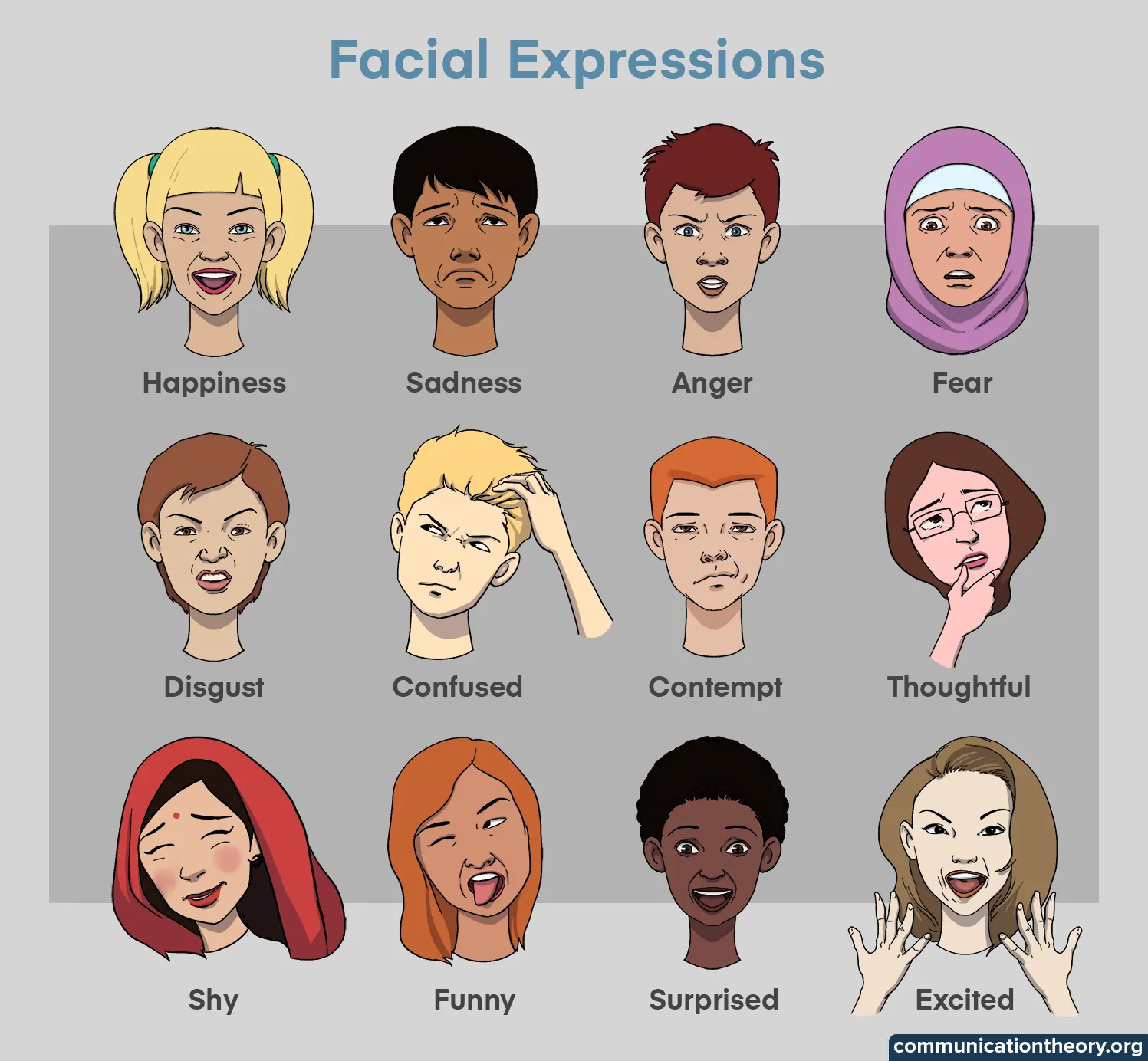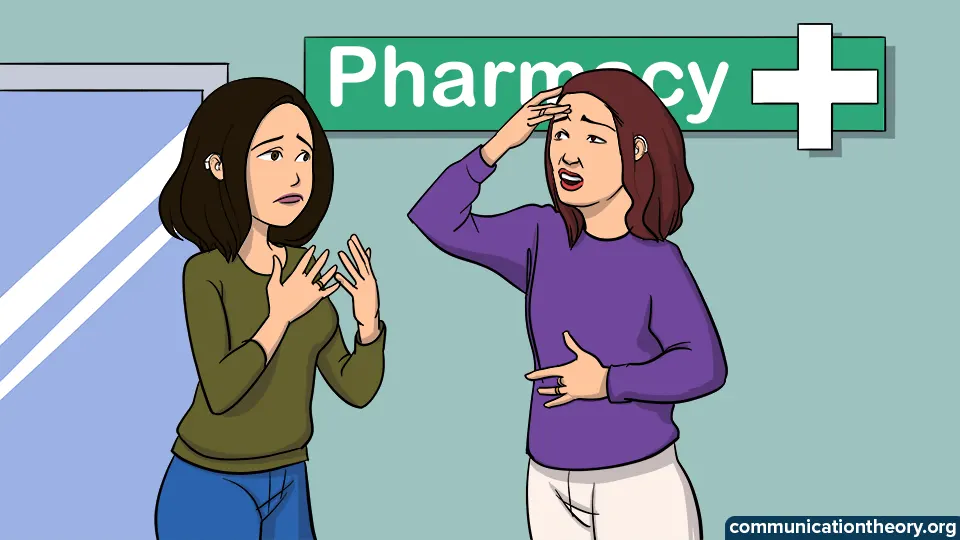Non-verbal communication includes conveying opinions, thoughts or feelings without using spoken words. Body language, facial expressions and gestures can speak a lot on an individual’s behalf. People tend to express their feelings, moods and thoughts using facial expressions.
For example, when a parent is in a good mood and children can see it through their facial expressions, they are more likely to ask for a toy or permission to play outside. On the other hand, if the parent’s expression looks irritated or upset, the child is less likely to ask for toys or permission.

A facial expression is an important form of non-verbal communication. It is a very essential form of communication between humans as well as other animal species. They can be used to convey a wide range of emotions, including happiness, sadness, anger, fear, excitement, etc.
Research evidence states that people can use seven universal expressions, across multiple cultures. These expressions are anger, contempt, disgust, fear, happiness, sadness and surprise. They can be used across a wide array of contexts, including face-to-face conversations, sign language and computer-mediated conversations (through video calls or the use of emoticons).
Social Anxiety Disorder and Facial Expressions
Social Anxiety Disorder makes it difficult for people to accurately pay attention and recognize expressions. It makes them prone to noticing more negative expressions than positive ones. Even neutral expressions can be perceived to be negative due to social anxiety disorder. Eye contact can be difficult to maintain an obvious negative expressions are completely avoided.
Social-emotional agnosia refers to the inability to identify or recognize facial expressions and other non-verbal behaviour. This inability leads to a reduction in social interactions as the individual is unable to interpret non-verbal behaviours. People with social-emotional agnosia can come across as indecisive, conflicted, insensitive or distant. This inability is common in schizophrenia, autism and alexithymia. It is caused due to an abnormality in a part of the brain called the amygdala.
Facial Expression and its evolution
Darwin introduced the idea that some facial expressions originate from evolution. These expressions might have helped humans to survive as they were able to express relevant emotions through certain behaviours and expressions. (fear, anger) This could have helped in avoiding conflict or danger.
Sign Languages and Facial Expressions

Sign languages are the innate linguistic systems that develop within a deaf community and have phonological, lexical, and syntactic levels of structure, just like spoken languages. They use facial expressions to communicate effectively as well as grammatical information.
Cognitive and neuro-cognitive evidence provides support for the signed and spoken language processing occurring similarly. Facial and head motions are utilized in sign languages at all degrees of linguistic structure. They also use facial gestures to communicate. Changes in eyebrow, mouth, head and body movements can impact the meaning of the facial expressions.
For example, if a singer raises her eyebrows while singing ‘going inside the hall’, it conveys the meaning of a question, ‘Are you going inside the hall?’
Eyes
The eyes are an essential part of a facial expression.
For example, people can smile through their eyes, blinking can be used to assess lying or nervousness.
Eye contact is also an important form of communication between people and is used to form connections. Dilated pupils are known to signify interest or arousal. Intense staring can mean attention or anger, whereas looking away can mean disinterest or discomfort. The significance of eyes can be understood through phrases such as ‘eyes are the windows to the soul.’
Mouth
The mouth can convey a variety of emotions. A smile is the most popular expression expressed through the mouth. People also tend to hide their actual emotions through their expressions.
For example, forcefully smiling in an awkward situation. There are some noticeable expressions such as a dropped jaw that conveys surprise, raised corners, conveying happiness, an open mouth that conveys fear, covering the mouth, as to resist or hide emotion, and lip biting used to convey anxiety.
Eyebrows
Eyebrows, like eyes, can be used to convey a range of emotions. For example, raised eyebrows can signal surprise or ask a question. Low or knotted eyebrows can convey anger or sadness.
Voluntary and Involuntary Expressions
Humans can have voluntary or involuntary expressions. Voluntary expressions can be socially conditioned and are consciously made whereas involuntary expressions are innate.
For example, bumping into someone you know and like in public could trigger an involuntary smile. Voluntary expressions can be made while greeting a teacher and smiling at them. The neural mechanisms behind both types of expressions are different. Voluntary expressions usually follow a cortical route in the brain. These expressions arise from the primary motor cortex and are in an individual’s control.
On the other hand, involuntary expressions follow a subcortical route in the brain. These expressions arise from the extrapyramidal motor system and are expressed unconsciously or naturally. They are not so much in our control. These expressions are expressed by infants under the age of 2. People can be unaware of displaying these expressions.
Micro-expressions
Micro-expressions are hidden or concealed emotions. They could also be non-verbal signs of fast processed emotions. They occur so rapidly that most people cannot recognize them. Micro-expressions originated from Darwin’s inhibition hypothesis which proposed that facial expressions which cannot be voluntarily controlled could be produced involuntarily even if people are trying to control or hide their expressions.
This happens as 2 neural pathways develop facial expressions, each coming from a distinct area of the brain. The pyramidal tract develops voluntary facial expressions and comes from the cortical motor strip, whereas the extra-pyramidal tract helps in developing involuntary expressions and originates from sub-cortical areas of the brain.
When individuals are in intense situations and have to conceal their original expressions, it activates both the pathways, which leads to a neural confusion for a few seconds leading to a rapid display of micro-expression.
Key points to remember
- Facial expressions can be beneficial and can be used to our advantage. They can help us watch and understand movies or TV shows in different languages without subtitles.
- We can interpret the context of the movie by observing the facial expressions and gestures of the characters. For example, Charlie Chaplin used facial expressions to convey so much information. Mr. Bean is also a show that utilized facial expressions to convey plots.
- We also tend to express facial expressions through the use of emoji on social media applications. A smiley emoji is used to convey happiness or excitement, a laughing emoji is used during a joking context and a crying or sad emoji is used to convey negative emotions. Emojis play an important part in virtual conversations as they help in giving more clarity to expressions.
Cartoons and Facial Expressions
Study by: Shu Zhang and colleagues
Aim: To investigate the recognition of emotional cartoon expressions and the influence of key facial features on the recognition of emotion in cartoon faces.
Method:
- Three experiments were conducted. Experiment 1 explored the recognition of emotional expressions for cartoon faces. Experiments 2 and 3 investigated the sufficiency and requirement of single facial features for emotional expression recognition.
- For the sake of the study, three common emotions (happy, neutral and sad) and three facial features (eyes, mouth and eyebrows) were used.
- Participants were exposed to cartoon facial expressions for a few seconds. Post the exposure, they had to rate the image based on emotional intensity.
Results:
- It was found that happy cartoon expressions were identified more easily than neutral and sad expressions.
- It was also found that sad cartoon faces were perceived as sadder than real facial expressions and happy cartoon faces were perceived to be less happy than real facial expressions.
Thank you for keeping me updated.
Good morning. I am finalizing the writing of the book “14 Key Themes in the Life of the Brazilian Family”, corresponding one of the themes to “The Process of Communication in the Family”, and one aspect related to this theme refers to non-verbal communications. In your article I am interested in using an image containing 12 facial expressions, which would help the reader to understand the definitions and implications of this aspect.
Sincerely
Dr. Diofante Acevedo Gamboa (Author)